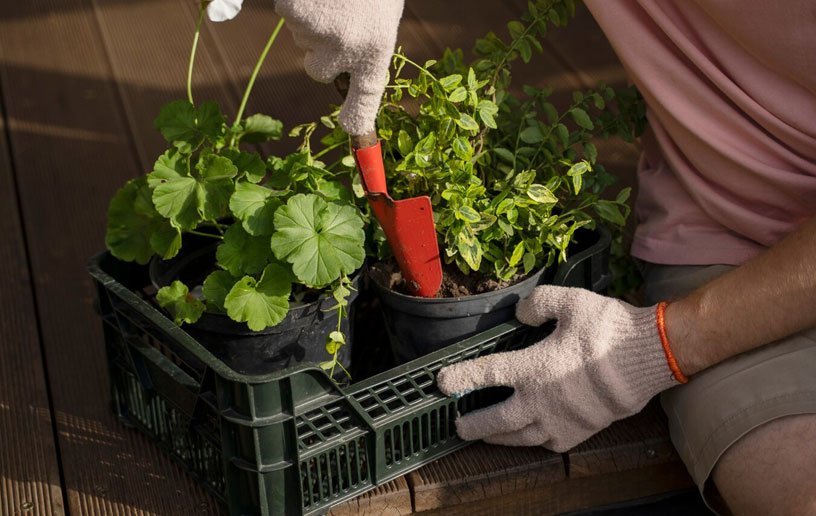Have you ever wished for a lush, vibrant garden but felt limited by a lack of outdoor space? Container gardening might just be the answer you’ve been searching for. Imagine transforming your balcony, patio, or even a sunny window sill into a fascinating oasis bursting with color, texture, and life. The beauty of container gardening lies in its versatility and the boundless creativity it allows, enabling you to curate a miniature paradise tailored to your personal style and space constraints.
In this comprehensive guide, we’ll dive into the fascinating world of container gardening, unveiling the secrets to crafting stunning and thriving gardens within the confines of containers. From selecting the perfect plants to mastering the art of arrangement, we’ve got you covered. So, grab your favorite gardening gloves and get ready to start a journey that will transform your outdoor space into a breathtaking horticultural haven.
Understanding Container Gardening
Container gardening is the practice of cultivating plants in portable containers, such as pots, planters, or window boxes, rather than directly in the ground. This gardening method offers numerous advantages, making it an attractive choice for those with limited outdoor space or those seeking flexibility and portability.
One of the primary benefits of container gardening is its adaptability. Containers allow you to create a garden virtually anywhere, from balconies and patios to rooftops and even indoors with the right lighting conditions. This flexibility is particularly appealing for urban dwellers or those with small outdoor areas.
Additionally, container gardening provides greater control over the soil quality and growing environment. By using high-quality potting mixes tailored to your plant’s needs, you can ensure optimal growth and health. This level of control is harder to achieve in traditional in-ground gardens, where soil quality can vary.
When it comes to containers, the options are endless. From classic terracotta pots to modern, sleek planters, and even repurposed household items like vintage tubs or tin cans, the possibilities for expressing your creativity are boundless. The key is to choose containers that not only complement your desired aesthetic but also meet the specific requirements of your chosen plants.
Selecting the right container size and material is important for the success of your container garden. Larger plants typically require larger containers to accommodate their root systems, while smaller plants can thrive in compact containers. Additionally, consider the material’s durability, weight, and insulation properties, as these factors can impact plant growth and maintenance.
Planning Your Container Garden
Before diving into the world of container gardening, it’s essential to assess your available space and sunlight conditions. Determine the areas that receive the most sunlight throughout the day, as this will guide your plant selection and container placement.
Next, decide on the theme or style you want to achieve for your container garden. Do you envision a modern, minimalist aesthetic with clean lines and bold colors? Or perhaps a rustic, cottage-inspired garden with a charming, whimsical vibe? Establishing a clear vision will help you make informed choices about plants, containers, and overall design.
Once you’ve determined your theme, create a plan for the layout and placement of your containers. Consider grouping containers of varying sizes and heights to create depth and visual interest. Sketch out your garden ideas or use any garden designing software to visualize the arrangement before implementing it.
Selecting Plants for Your Container Garden
One of the most exciting aspects of container gardening is the opportunity to showcase a diverse array of plants in a compact space. When selecting plants, consider those that thrive in your climate and sunlight conditions, as well as their mature size and compatibility with container gardening.
For a truly fascinating display, incorporate a variety of plants with different growth habits, textures, and colors. Upright plants can provide height and structure, while trailing varieties can cascade over the edges of containers, adding movement and softness. Flowering plants offer bursts of color and attract pollinators, while foliage plants contribute interest through their unique shapes and hues.
When planning your plant combinations, consider the growing seasons and blooming periods to ensure a continuous display of color and interest throughout the year. Mixing annuals, which complete their life cycle in a single season, with perennials, which return year after year, can create a dynamic and ever-changing garden.
Preparing the Containers
Before planting, it’s important to prepare your containers properly. Start by thoroughly cleaning and disinfecting the containers to remove any lingering pests, diseases, or debris from previous plantings. This step helps ensure a fresh start for your new garden.
If your containers lack drainage holes, consider adding them to prevent waterlogging and root rot. Proper drainage is essential for maintaining healthy plants and preventing soil compaction.
Next, fill your containers with a high-quality, well-draining potting mix specifically formulated for container gardening. Avoid using garden soil, as it can become compacted and waterlogged in containers, leading to poor plant growth and potential root issues.
Arranging Your Container Garden
With your containers and plants ready, it’s time to bring your vision to life. The arrangement of your containers plays a important role in creating a visually striking and cohesive garden.
Group containers of varying sizes and heights together for a sense of depth and visual interest. Taller plants or larger containers can serve as focal points, drawing the eye inward and creating a sense of order within the arrangement.
When positioning your containers, consider the mature size and growth habits of your plants. Taller plants should be placed in the back or center, while shorter varieties can frame the front or sides. Leave enough space between containers to allow for easy access and maintenance.
Remember, your container garden should be enjoyed from all angles, so consider the placement of containers based on viewpoints and accessibility. Strategically position statement plants or containers with vibrant colors or textures to create eye-catching vignettes.
Caring for Your Container Garden
While container gardening offers convenience and flexibility, it also requires consistent care and maintenance to ensure your plants thrive. One of the most important aspects is establishing a regular watering schedule tailored to your plant’s needs and the weather conditions.
During hot, dry periods, potted plants may require daily watering, while cooler or more humid conditions may allow for less frequent watering. Regularly check the soil moisture by inserting your finger into the potting mix – if the top inch or two feels dry, it’s time to water.
In addition to watering, your container garden will benefit from regular fertilization. Potted plants have limited access to nutrients, so providing a balanced liquid fertilizer every few weeks during the growing season can help maintain their health and vigor.
Pruning and deadheading spent flowers are also essential tasks for maintaining a tidy and vibrant container garden. Removing faded blooms encourages continuous flowering, while judicious pruning promotes healthy growth and helps maintain the desired shape and size of your plants.
Vibrant Container Garden
To create a truly vibrant and eye-catching container garden, embrace a diverse palette of colors, textures, and growth habits. Incorporate both flowering and foliage plants, as the combination of blooms and interesting foliage will keep your garden visually engaging throughout the seasons.
Trailing plants like ivy, sweet potato vines, or cascading petunias can add a dynamic element by spilling over the edges of containers, softening the overall look and creating a sense of movement.
Don’t be afraid to experiment with annuals, perennials, and even edible plants like herbs or small vegetables. The beauty of container gardening lies in its flexibility, allowing you to mix and match different plants to create a unique and ever-changing display.
Regularly deadheading spent flowers and pruning plants can encourage new growth and continuous blooming, ensuring your container garden remains vibrant and lush throughout the growing season.
Successful Container Gardening
While container gardening may seem simple, there are a few key factors that contribute to its success. First and foremost, choose the right containers. Look for containers with proper drainage holes to prevent waterlogging and select sizes appropriate for the plants you plan to grow. Larger plants will require more ample containers to accommodate their root systems.
Use a high-quality, well-draining potting mix specifically formulated for container gardening. Garden soil can become compacted and waterlogged in containers, leading to poor plant growth and potential root issues.
Consistent watering is important for the health of your potted plants. Check the soil moisture daily and water whenever the top inch or two of the potting mix feels dry. During hot, dry periods, you may need to water more frequently.
Provide your plants with the appropriate amount of sunlight based on their needs. Observe the sunlight patterns in your outdoor space and position your containers accordingly. Some plants thrive in full sun, while others prefer partial shade or filtered light.
Fertilization is essential for maintaining the vigor and health of container-grown plants. Use a balanced liquid fertilizer every two weeks during the growing season to replenish the quickly depleted nutrients in potted environments.
Regularly inspect your plants for signs of pests or diseases, and address any issues promptly. Early intervention can prevent minor problems from becoming major setbacks in your container garden.
Container Shape Considerations
When it comes to selecting containers for your garden, the shape you choose can have a significant impact on both the aesthetic appeal and the practical considerations of your setup. While there is no one-size-fits-all solution, certain container shapes lend themselves better to specific plant types, design styles, and spatial constraints.
1. Round or Square Containers
Round or square containers are classic choices that work well for a variety of plants and can be easily arranged in groups or clusters. These shapes provide a timeless look and can complement various design themes, from modern minimalism to rustic charm.
2. Rectangular or Window Box Containers
Rectangular or window box containers are ideal for small spaces like balconies or patios. Their long, narrow shape allows you to create a linear display, perfect for trailing plants or showcasing a row of upright specimens. These containers can also be mounted on railings or walls, adding vertical interest to your outdoor space.
For those seeking a unique and space-saving solution, tiered or stacked containers offer an innovative approach. These designs allow you to grow more plants in a limited footprint, creating a visually striking and layered effect. Trailing plants can cascade down the sides, while upright varieties can be featured on the top tiers.
3. Hanging Baskets
Hanging baskets are another popular option for container gardening, particularly when vertical space is at a premium. These suspended containers are perfect for trailing plants that can cascade over the sides, adding height and movement to your garden. They can be hung from pergolas, eaves, or even mounted on walls or fences.
Ultimately, the shape of your container should complement your chosen plants, available space, and personal design preferences. Experiment with various shapes and combinations to create a container garden that is both functional and visually appealing.
Troubleshooting Common Issues
Despite your best efforts, container gardens can sometimes encounter challenges. From wilting or yellowing leaves to pest infestations and nutrient deficiencies, it’s essential to be prepared to address these common issues promptly.
1. Overwatering or Underwatering
One of the most frequent problems faced by container gardeners is overwatering or underwatering. Wilting or yellowing leaves can be a sign of either too much or too little water. To avoid these issues, monitor the soil moisture regularly and adjust your watering schedule accordingly.
Pests like aphids, spider mites, or whiteflies can quickly become a nuisance in container gardens. Regularly inspect your plants for signs of infestation and take action immediately. Insecticidal soaps, neem oil, or other organic pesticides can help control these unwanted visitors without harming beneficial insects.
2. Nutrient deficiencies
Nutrient deficiencies can also manifest in various ways, such as yellowing leaves, stunted growth, or discolored foliage. Consistent fertilization with a balanced liquid fertilizer can help prevent these issues, but it’s important to follow the recommended application rates to avoid over-fertilization.
If you notice signs of disease, such as spots, mildew, or discolored patches on leaves or stems, act quickly to prevent further spread. Removing affected plant parts, improving air circulation, and applying appropriate fungicides or organic treatments can help control the problem.
3. Maintenance and Monitoring
Regular maintenance and monitoring are key to keeping your container garden healthy and vibrant. Deadheading spent blooms, pruning overgrown plants, and removing any debris or fallen leaves can prevent issues from escalating.
Remember, prevention is always better than cure. By following best practices for container gardening, such as using high-quality potting mixes, providing proper drainage, and ensuring adequate sunlight and water, you can minimize the likelihood of encountering common problems in your garden.
Conclusion
Container gardening is a fascinating and versatile approach to creating a lush, vibrant oasis in even the smallest of outdoor spaces. From selecting the perfect plants to mastering the art of arrangement, this guide has equipped you with the knowledge and inspiration to transform your balcony, patio, or window sill into a horticultural haven.
Embrace the limitless possibilities of container gardening by experimenting with different plant combinations, container shapes, and design styles. Let your creativity run wild as you curate a miniature paradise that reflects your taste and adds a touch of natural beauty to your living space.
Remember, the true joy of container gardening lies in the journey itself – the nurturing of delicate seedlings, the anticipation of bursting blooms, and the satisfaction of witnessing your efforts bloom into a stunning and ever-evolving display.
So, roll up your sleeves, grab your favorite gardening tools, and let your green thumb work its magic. Your very own container garden oasis awaits, promising countless hours of relaxation, enjoyment, and a profound connection with nature, right at your fingertips.




No Comment! Be the first one.